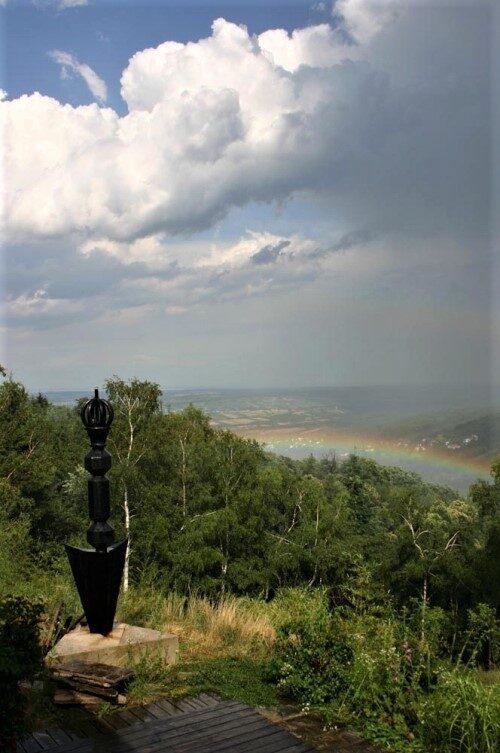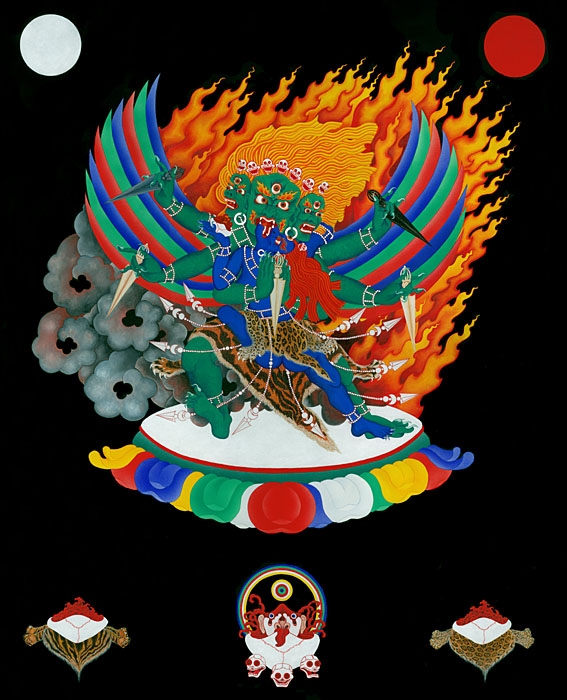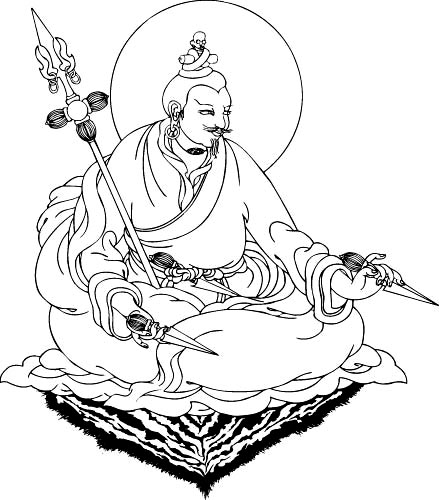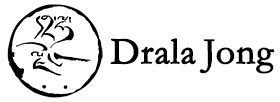Building a Monumental Phurba at Drala Jong
“In the 20th Century, the renowned gTertön Sonam Zangpo Rinpoche prophesied that a large statue of either Padmasambhava, Shakyamuni Buddha, or a Monumental Phurba should be built in the West in order to bring auspicious circumstances, peace, and happiness to the planet.”
“In 1980, during an interview that took place in California, Kyabje Düd’jom Rinpoche told Chag’düd Tulku Rinpoche that Dorje Phurba would be especially helpful in removing obstacles to Vajrayana being established in the West.”

Vajrayana Buddhism is a vast system of methods which facilitate the discovery of one’s natural state. This natural state is one where human goodness, spacious presence, and communicative appreciation are discovered to be our essential nature. In everyday existence however, we fail to recognise this.
Vajrayana describes reality as the nondual dance of two seeming opposites: form & emptiness. In the understanding of Vajrayana, we are both existent and non-existent. Our dilemma lies in compulsively seeking solidity, permanence, separateness, continuity, and definition in order to feel safe. We flee their opposites: insubstantiality, impermanence, non-separateness, discontinuity, and lack of definition — because we feel that they negate existence. But because form and emptiness – existence and non-existence – cannot be separated, this activity is fruitless.
As long as we attempt to separate the form and emptiness qualities of experience, we limit human responsiveness to three modes: attraction, aversion, and indifference. If what is perceived comforts feelings of solidity, permanence, separateness, continuity, and definition – one will be attracted. If what is perceived generates feelings of insubstantiality, impermanence, non-separateness, discontinuity, and lack of definition – one will be averse and attempt to avoid it. If what is perceived does neither — one will be indifferent and ignore it.
When experience is characterised by attraction, aversion, and indifference one ‘goes around in circles’ – this is the Tibetan meaning of khorwa, better known in the West by its Sanskrit equivalent: samsara. Khorwa is a self-defeating process where one goes around in circles trying to find happiness yet unfailingly creating the causes of further unhappiness.

Wrathful imagery
All Buddhist teachings help us to understand this predicament — and apply remedies. The genius of Vajrayana however, lies in the capacity to use the energy of confusion against confusion itself. This was the awakened intention of Guru Rinpoche—Padmasambhava—the Buddha of the Tantras, and father of Vajrayana. It is said that the power of Guru Rinpoche’s legacy increases as the confusion of sentient beings intensifies.
Using the energy of confusion against itself is described as awakened activities. These awakened activities—Buddha-karmas—are increasingly energetic ways of interacting with dualistic derangement. The most forceful of these modes is the Buddha-karma of destruction. When all else fails – nondual intention is left with no alternative but to destroy confusion in order to facilitate liberation.
This is why Vajrayana is rife with wrathful imagery connected to the Buddha-karma of destruction: flames, corpses, bulging eyes, sacks of disease, severed heads, weapons of all shapes and sizes. Serene and smiling Buddhas are not the only portrayal of awakened intention – the powerful energy of the Buddha-karma of destruction is as valid a manifestation of nondual realisation as the serenity of peaceful Buddhas. It is also more dynamic and direct.

Phurba
Wrathful imagery portrays a great many weapons — and they are invariably used to symbolically destroy duality. Of all these weapons the phurba is perhaps quintessential. What is being destroyed? The phurba is called the dagger of emptiness because it symbolically pierces the distorted fabric of duality in order to reintroduce the nonduality of emptiness and form. The phurba destroys the tendency to wilfully obfuscate the natural state. Obduracy, irritation, rapacity, restlessness, desire for oblivion: are actively encouraged in order to occlude the beginningless nondual condition. Fundamentally, this is what the phurba destroys.
In the Mahayoga view, the phurba—as a physical implement—is a manifestation of the meditational awareness being Dorje Phurba – Indestructible or Thunderbolt nail. To Nyingma practitioners, Dorje Phurba is synonymous with Guru Rinpoche. He is said to have requested the phurba teachings from India whilst in the process of establishing Vajrayana in Tibet. Local spirits were causing obstacles to the establishment of the teachings in Tibet. Upon accomplishing the practice of Dorje Phurba, Guru Rinpoche was capable—in the guise of Dorje Tröllö, his most wrathful manifestation—to overcome all obstacles to the introduction of Vajrayana.
In the view of Dzogchen, the highest Nyingma teaching, the phurba is a self-existent symbol of liberation. Dzogchen emphasises recognition of the natural state, rather than forcefully transforming or transmuting confusion. The Dzogchen phurba therefore functions as an instant reminder of the natural state. This is the essential meaning of the monumental phurba to be built at Drala Jong: a symbol of the ever-present awakened nature.

A-Kyong Düd’dül Dorje
Up to this day, it is a traditional practice across Buddhist traditions to build chörten (also known as stupas) in various physical locations. Chörten vary widely in size and detail; some are built in valleys, others in mountain passes – but their meaning is the same: the pattern of geometric shapes are symbolic representations of Buddha mind. When and where they are built, there is always the intention to benefit the land and its inhabitants.
In the Aro gTér tradition, the practice of building physical manifestations of Buddha mind takes the form of monumental phurbas. The tradition arose with a great practitioner of phurba called Ngak’chang A-Kyong Düd’dül Dorje. He was a student of Khyungchen Aro Lingma (1886–1923), the female visionary who discovered the Aro gTèr. He was a gTértön (discoverer of visionary teachings) in his own right. Following Aro Lingma’s instructions as to location he would build monumental phurbas which would vary in size from a few feet to a dozen.
The design of the monumental phurba that is planned for Drala Jong is based on A-Kyong Düd’dül Dorje’s enriching design. As such, its intention is to enrich the land in such a way as to inspire practice, the cultivation of sanity, and the protection of the natural environment. It stands as monument to World Peace and to its actualisation. Whoever sees it on Open Teaching Retreats, or hears of it, will be inclined to greater generosity, gentleness, kindness, beneficent alacrity, and open-mindedness.
Donate to Drala Jong
Please act today, and donate a lump sum or establish a standing order for a monthly contribution. No matter how small or big – we are utterly grateful for every donation.

